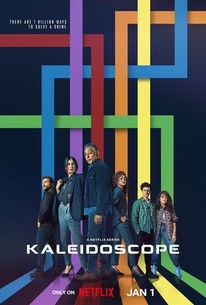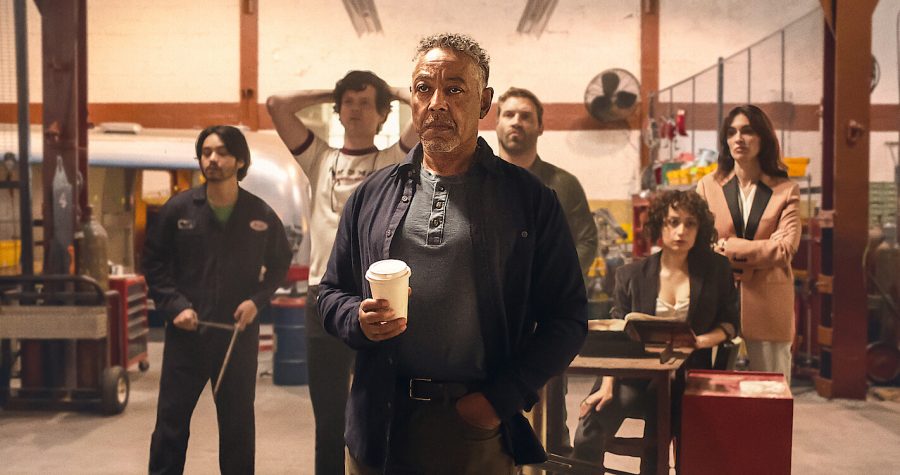Review: ‘Kaleidoscope’ is an interesting yet flawed experiment
January 6, 2023
Netflix’s limited series “Kaleidoscope,” tells the tale of a multi-billion dollar heist led by Leo Pap (Giancarlo Esposito), with betrayal, history and revenge at every turn.
A pretty basic heist series, In all ways but one. The first seven episodes of the eight-part series are put in a random order for each viewer. Thus, the episodes are labeled by color, rather than number.
My random order was “Green,” “Yellow,” “Violet,” “Orange,” “Blue,” “Red,” “Pink,” followed by “White”- the only episode seen at the same place for every account.
I would sort these episodes into three broad categories: The distant past (“Violet” and “Green”), the planning of the heist (“Yellow,” “Orange” and “Blue”), and the aftermath (“Red” and “Pink”). “White” is the exception to these, as it features the heist itself.
The viewer is meant to see all the disparate pieces surrounding the heist, before seeing the act itself. The randomized order allows for each viewer to see the pieces come together in a unique way, forming different opinions and narratives before the heist actually goes down.
I think this is a great concept, but it can fall flat in “Kaleidoscope”- The random order of the episodes has the potential to make things either really fun or really confusing for the viewer.
Or, in my case, somewhere in between.
I got the episodes in almost perfect chronological order, Which made things kind of boring. The one episode I had out of order was hugely rewarding, as I was able to connect it firmly to things I had seen happen in the future, but for the most part, all I could do is connect things back to past episodes just like I would in any show.
Ideally, I would’ve liked to see this series with a greater mix of episodes, allowing me to make connections to the past and the future, not just the past.
A chronological order fell a little flat for me, but that isn’t the only way this show can fail- a completely random order can make the viewer spend so much time trying to figure out what’s happening that they can’t make connections between the episodes- they’re just confused.
But as long as the episodes aren’t randomized into a completely confusing order, “Kaleidoscope” works in making the viewer think and put the puzzle pieces together themselves, which is really fun.
Of course, that puts viewers at the mercy of a random number generator, not only getting different experiences, but different qualities of experience, which is a huge problem.
This isn’t to say that I dislike the concept of a randomized order. I actually think it can work quite well, but only in certain situations.

I think the concept would work the best for a murder mystery, where we can see events from a variety of perspectives at the same time, rather than jumping around a 20-some-year timeline.
The actual story of “Kaleidoscope” is a pretty traditional heist drama, as I mentioned before. It differed in a few ways- Pap’s motivation for pulling the heist was fairly unique, and the cast of characters he assembled managed to stay away from the tropes of other heist stories.
In my experience, most heist stories either involve the best of the best criminals coming together for an uber-high-tech and professional job, or a group of desperate people working with what they have to get rich.
The characters of “Kaleidoscope” certainly aren’t the best at what they do, nor are they all that desperate. They have Pap as their leader and Ava Mercer (Paz Vega) supplying their endeavor, but none of the other members can really be described as particularly “elite” criminals. There’s a smuggler, an explosives expert, a safecracker and a driver, but none of them are “the best” at what they do by any means.
Outside of Pap’s storyline, which was emotional and compelling, everything in the show seemed almost over-exaggerated for the sake of even the viewer paying the least attention being able to connect the episodes.
So if you’re looking for a really good story, you might want to turn elsewhere. If you’re looking for a unique experience though, I’d highly recommend watching “Kaleidoscope.”
If a unique viewing order gives you a different perspective than what I describe above, be sure to comment on this article or find me on Twitter @jpfeifferCT. I’d love to hear what you thought!








